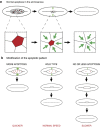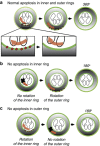Shaping organisms with apoptosis
- PMID: 23449394
- PMCID: PMC3619238
- DOI: 10.1038/cdd.2013.11
Shaping organisms with apoptosis
Abstract
Programmed cell death is an important process during development that serves to remove superfluous cells and tissues, such as larval organs during metamorphosis, supernumerary cells during nervous system development, muscle patterning and cardiac morphogenesis. Different kinds of cell death have been observed and were originally classified based on distinct morphological features: (1) type I programmed cell death (PCD) or apoptosis is recognized by cell rounding, DNA fragmentation, externalization of phosphatidyl serine, caspase activation and the absence of inflammatory reaction, (2) type II PCD or autophagy is characterized by the presence of large vacuoles and the fact that cells can recover until very late in the process and (3) necrosis is associated with an uncontrolled release of the intracellular content after cell swelling and rupture of the membrane, which commonly induces an inflammatory response. In this review, we will focus exclusively on developmental cell death by apoptosis and its role in tissue remodeling.
Figures




References
-
- Potts MB, Cameron S. Cell lineage and cell death: Caenorhabditis elegans and cancer research. Nat Rev Cancer. 2010;11:50–58. - PubMed
-
- Zakeri Z, Quaglino D, Ahuja HS. Apoptotic cell death in the mouse limb and its suppression in the hammertoe mutant. Dev Biol. 1994;165:294–297. - PubMed
-
- Coleman ML, Sahai EA, Yeo M, Bosch M, Dewar A, Olson MF. Membrane blebbing during apoptosis results from caspase-mediated activation of ROCK I. Nat Cell Biol. 2001;3:339–345. - PubMed
-
- Crawford ED, Wells JA. Caspase substrates and cellular remodeling. Ann Rev Biochem. 2011;80:1055–1087. - PubMed
Publication types
MeSH terms
Grants and funding
LinkOut - more resources
Full Text Sources
Other Literature Sources
Molecular Biology Databases

